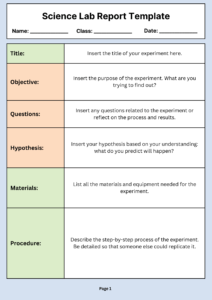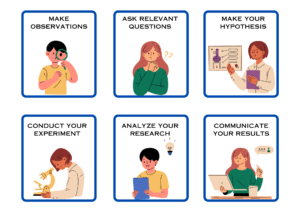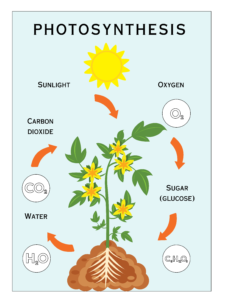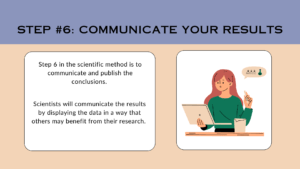In this article, we’ll look at 6 basic steps to teaching the scientific method and explore why homeschooling parents and their students will come to appreciate what new discoveries the scientific method brings to their problem solving and critical thinking skills.
In teaching the scientific method, we also look to share 6 engaging websites as well as our own science resources for homeschooling curriculums.
What is the Scientific Method?
The scientific method can be a powerful tool for homeschooling parents to guide their teaching and learning process. It involves a systematic approach to problem-solving and inquiry, which can help make learning more effective and engaging.
Download this set of scientific method flashcards that can be laminated and displayed to help encourage children remember these six important steps to the scientific method.
Importance of Learning the Scientific Method:
Mastering the scientific method goes beyond understanding scientific concepts—it cultivates essential skills that are applicable across various disciplines and in everyday life.
- Critical Thinking: The scientific method teaches students to think critically, question assumptions, and evaluate evidence objectively. These skills are invaluable in making informed decisions and solving problems.
- Problem-Solving: By following a structured approach to inquiry, students learn how to break down complex problems into manageable steps and develop systematic strategies for solving them.
- Creativity: Science is as much about creativity as it is about logic. Through hypothesis formulation and experimental design, students are encouraged to think outside the box and explore innovative solutions to challenges.
- Resilience: Not every experiment yields the expected results, and that’s okay. The scientific method teaches students to embrace failure as an opportunity for learning and refinement, fostering resilience and perseverance.
- Empirical Thinking: In a world inundated with information, the ability to discern fact from fiction is essential. By emphasizing evidence-based reasoning, the scientific method equips students with the tools to distinguish between credible information and pseudoscience.

Steps to the Scientific Method
:Here’s how you might apply the scientific method in a homeschooling context:
Watch this short video to get a sneak peak of the steps written down below. Download your copy of our scientific method worksheet to use in your classroom today!
Step 1: Make Observations
This step involves gathering information through senses in order to understand the world around us. This step sets the stage for formulating a question and then a hypothesis based on what children observe around a topic that interests them.This step can also involve researching existing knowledge about the topic.

Whether it’s through books, websites, or interviews, students should seek to understand what others have already discovered in order to help create a new question.
Step 2: Ask a Question
Every scientific inquiry involves a well thoughtout question. Encourage chilren to think about ‘why’ things are the way they are. Questions like “Why does it rain?” or “What makes plants grow?” lay the foundation for scientific exploration.

Step 3: Formulate a Hypothesis
With background knowledge in hand, students can formulate a hypothesis—a proposed explanation for the phenomenon they’re investigating. Hypotheses should be testable and based on logical reasoning. Encourage creativity and critical thinking during this step.
Step 4: Test Your Hypothesis
Now comes the fun part—experimentation. Students design and conduct experiments to test their hypotheses. Emphasize the importance of controlled experiments, where only one variable is changed at a time to accurately assess its impact. This step involves making observations, collecting data, and analyzing results.

Step 5: Analyze Data and Draw Conclusions
Once the data is collected, it’s time to analyze it. Students should look for patterns, trends, and relationships within the data. Did the results support their hypothesis, or do they need to revise their thinking? Encourage them to draw conclusions based on evidence rather than personal bias.

Step 6: Communicate Your Results
The final step of the scientific method is sharing findings with others. Whether it’s through a written report, a presentation, or a poster, students should communicate their research process, results, and conclusions clearly and accurately. This step fosters collaboration and allows others to learn from their discoveries.

Scientific Method Presentation
Homeschooling parents can use our scientific method presentation made in Canva to enhance their child’s learning experience by providing a structured approach to exploring and understanding various subjects. Click here to access your copy of our presentation guide.
Lab Safety
Lab safety in the homeschool classroom is essential to ensure a safe and productive learning environment when conducting experiments. Use this poster to help reinforce safety while doing experiments in the homeschool classroom. Download this free lab safety rules poster courtesy of our Canva teaching guides for the homeschooling classroom.
For more teaching resources, consider subscribing to our teaching resources newsletters!
Related Topics:
- Homeschooling Science Blogs
- Science related resources on Canva
- Science Rubrics for the Homeschool Classroom
- Five Summer Time Activities To Do At Home
- Educational Strategies to Transform Homeschool Learning
- From Kitchen to Classroom: Enhancing Your Life Skills
- Educational Videos for the Homeschool Classroom
- Helping Children Build Successful Recipes for Learning
Final Thoughts…
In the journey of scientific discovery, the scientific method serves as a trusty compass, guiding young explorers through the realms of curiosity and wonder. By mastering its steps, grade six students not only unravel the mysteries of the natural world but also cultivate essential skills that will serve them well throughout their academic and personal pursuits.
Click to use our presentation tool bundle on the scientific method, and interactive science platforms to conduct virtual experiments or analyze data.
So, let’s encourage their inquisitive spirits, nurture their curiosity, and empower them to embark on the thrilling adventure of scientific inquiry. Who knows what wonders they’ll uncover along the way?
Share Your Thoughts
EduKitchen would like to hear from you. Leave us a comment below on the your thoughts about using the scientific method in the homeschooling classroom.









